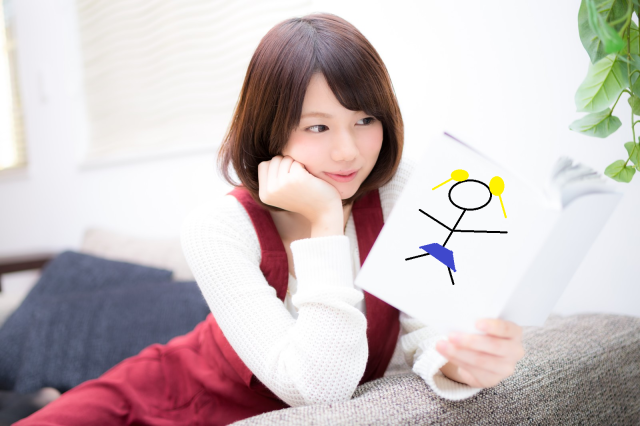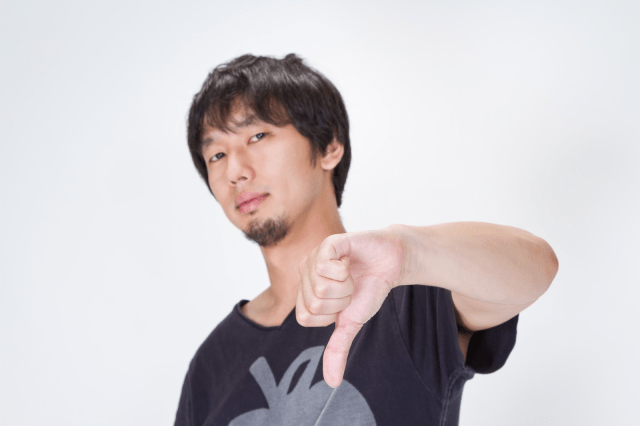
With so many manga to choose from, looking for one you don’t want to look at might just be crazy enough to work.
“Lots of manga to choose from” doesn’t seem like it should be a problem, and for many otaku, who awaken to their love of animation and comics during their teen years, it’s not. But when adult life hits, grown-up responsibilities gradually chip away at your amount of free time and the practicality of staying up until 2 in the morning every day reading comics.
As leisure time becomes more precious, “just read everything” stops being an option, and finding a series you truly enjoy becomes the difference between a refreshing hour or two of after-work entertainment or a waste of an entire evening. But with mountains of manga being published these days, how do you mine the gems that are really interesting reads? Japanese Twitter user @minetabby recently shared a unique, and seemingly very counterintuitive, method.
むかし友人に「面白い漫画ってどうやって見つけるの」って言われて「表紙の絵がクソ下手でも3巻以上出てる漫画は絶対に面白い」って返した
— 地雷ねこ (@minetabby) May 13, 2020
@minetabby’s strategy, which originally comes from a friend, is to first search for a manga that has “crappy cover artwork.” Next, check how many collected volumes of the series have been published. If it’s three or more, the manga will, “absolutely,” be worth reading.
On the surface, the “crappy cover” plan seems like it’d immediately backfire. Art aesthetics are a key part of what makes manga manga. Take away the pictures and they’d be novels (novels with sound effects, but still, novels). So why go out of your way to search for a series with art you don’t like?
The tweet doesn’t say, but a few ideas spring to mind. First, while it’s true that a manga without art would be a novel, a manga without words would be just an art collection. It’s the mix of pictures and words that makes it a manga, so if a manga can make it to three collected volumes without appealing artwork, it stands to reason that it must be making up for the sub-par art with a more-interesting-than-average story, themes, and/or characterizations.
In Japan, almost all manga is published in weekly serialized format, in anthologies that constantly swap out unpopular series and replace them with new ones. Individual series’ collected volumes usually contain about a dozen chapters, so by the time a manga makes it to its third volume, it’s been in serialization for about nine months, plus any lead time between when the serialized chapters appeared and the collected volume was printed and distributed. With the Japanese manga market being hyper competitive, that’s more time than most publishers are willing to grant an underperforming title, so the combination of off-putting art plus longevity suggests that there must be something special that’s made a fanbase latch onto it.
There’s also likely one more factor at play. While it’s an oft-repeated exaggeration that all anime and manga characters look alike, it’s definitely true that broad design trends periodically ripple out throughout the industry. It’s not at all hard for publishers to find artists who can draw, with passable quality, in whatever the current flavor of the month style is. With OK-quality art in abundance, any manga that’s standing out from the norm enough to seem “crappy” probably isn’t interested in trying to parrot the biggest mainstream hits, and that willingness to do its own thing just might lead you to a series that offers you something you can’t get anywhere else.
Related: Twitter/@minetabby via Jin
Top image: Pakutaso (edited by SoraNews24
Insert images: Pakutaso
● Want to hear about SoraNews24’s latest articles as soon as they’re published? Follow us on Facebook and Twitter!


 Manga Art Hotel Tokyo welcomes foreign guests with over 5,000 manga, including English editions
Manga Art Hotel Tokyo welcomes foreign guests with over 5,000 manga, including English editions The 10 best manga to read in 2022, as recommended by Japanese bookstores
The 10 best manga to read in 2022, as recommended by Japanese bookstores Massive manga mural takes over Tokyo station to celebrate Jujutsu Kaisen【Photos】
Massive manga mural takes over Tokyo station to celebrate Jujutsu Kaisen【Photos】 Creator of Japan’s first pole dancing manga talks with our pole-dancing reporter【Interview】
Creator of Japan’s first pole dancing manga talks with our pole-dancing reporter【Interview】 Manga Art Hotel Tokyo: What it’s like to spend a night surrounded by 5,000 Japanese manga
Manga Art Hotel Tokyo: What it’s like to spend a night surrounded by 5,000 Japanese manga Foreigner’s request for help in Tokyo makes us sad for the state of society
Foreigner’s request for help in Tokyo makes us sad for the state of society Ghibli Park now selling “Grilled Frogs” from food cart in Valley of Witches
Ghibli Park now selling “Grilled Frogs” from food cart in Valley of Witches Harajuku Station’s beautiful old wooden building is set to return, with a new complex around it
Harajuku Station’s beautiful old wooden building is set to return, with a new complex around it Smash Bros. director Sakurai stabs Kirby in the face, has delicious justification for it
Smash Bros. director Sakurai stabs Kirby in the face, has delicious justification for it Red light district sushi restaurant in Tokyo shows us just how wrong we were about it
Red light district sushi restaurant in Tokyo shows us just how wrong we were about it Osaka governor suggests lowering voting age to 0 to curb population decline
Osaka governor suggests lowering voting age to 0 to curb population decline Historical figures get manga makeovers from artists of Spy x Family, My Hero Academia and more
Historical figures get manga makeovers from artists of Spy x Family, My Hero Academia and more Suntory x Super Mario collaboration creates a clever way to transform into Mario【Videos】
Suntory x Super Mario collaboration creates a clever way to transform into Mario【Videos】 The five least stressful jobs, as ranked by Japanese working people
The five least stressful jobs, as ranked by Japanese working people Japanese politician’s birthrate plan: Have parents nag their kids to have “at least three babies”
Japanese politician’s birthrate plan: Have parents nag their kids to have “at least three babies” McDonald’s new Happy Meals offer up cute and practical Sanrio lifestyle goods
McDonald’s new Happy Meals offer up cute and practical Sanrio lifestyle goods Japanese ramen restaurants under pressure from new yen banknotes
Japanese ramen restaurants under pressure from new yen banknotes French Fries Bread in Tokyo’s Shibuya becomes a hit on social media
French Fries Bread in Tokyo’s Shibuya becomes a hit on social media Studio Ghibli releases new action figures featuring Nausicaä of the Valley of the Wind characters
Studio Ghibli releases new action figures featuring Nausicaä of the Valley of the Wind characters New private rooms on Tokaido Shinkansen change the way we travel from Tokyo to Kyoto
New private rooms on Tokaido Shinkansen change the way we travel from Tokyo to Kyoto Tokyo Tsukiji fish market site to be redeveloped with 50,000-seat stadium, hotel, shopping center
Tokyo Tsukiji fish market site to be redeveloped with 50,000-seat stadium, hotel, shopping center All-you-can-drink Starbucks and amazing views part of Tokyo’s new 170 meter-high sky lounge
All-you-can-drink Starbucks and amazing views part of Tokyo’s new 170 meter-high sky lounge Beautiful Ghibli sealing wax kits let you create accessories and elegant letter decorations【Pics】
Beautiful Ghibli sealing wax kits let you create accessories and elegant letter decorations【Pics】 Studio Ghibli releases Kiki’s Delivery Service chocolate cake pouches in Japan
Studio Ghibli releases Kiki’s Delivery Service chocolate cake pouches in Japan New definition of “Japanese whiskey” goes into effect to prevent fakes from fooling overseas buyers
New definition of “Japanese whiskey” goes into effect to prevent fakes from fooling overseas buyers Our Japanese reporter visits Costco in the U.S., finds super American and very Japanese things
Our Japanese reporter visits Costco in the U.S., finds super American and very Japanese things Studio Ghibli unveils Mother’s Day gift set that captures the love in My Neighbour Totoro
Studio Ghibli unveils Mother’s Day gift set that captures the love in My Neighbour Totoro More foreign tourists than ever before in history visited Japan last month
More foreign tourists than ever before in history visited Japan last month New Pokémon cakes let you eat your way through Pikachu and all the Eevee evolutions
New Pokémon cakes let you eat your way through Pikachu and all the Eevee evolutions Sales of Japan’s most convenient train ticket/shopping payment cards suspended indefinitely
Sales of Japan’s most convenient train ticket/shopping payment cards suspended indefinitely Sold-out Studio Ghibli desktop humidifiers are back so Totoro can help you through the dry season
Sold-out Studio Ghibli desktop humidifiers are back so Totoro can help you through the dry season Japanese government to make first change to romanization spelling rules since the 1950s
Japanese government to make first change to romanization spelling rules since the 1950s Ghibli founders Toshio Suzuki and Hayao Miyazaki contribute to Japanese whisky Totoro label design
Ghibli founders Toshio Suzuki and Hayao Miyazaki contribute to Japanese whisky Totoro label design Doraemon found buried at sea as scene from 1993 anime becomes real life【Photos】
Doraemon found buried at sea as scene from 1993 anime becomes real life【Photos】 Tokyo’s most famous Starbucks is closed
Tokyo’s most famous Starbucks is closed One Piece characters’ nationalities revealed, but fans have mixed opinions
One Piece characters’ nationalities revealed, but fans have mixed opinions We asked a Uniqlo employee what four things we should buy and their suggestions didn’t disappoint
We asked a Uniqlo employee what four things we should buy and their suggestions didn’t disappoint Princesses, fruits, and blacksmiths: Study reveals the 30 most unusual family names in Japan
Princesses, fruits, and blacksmiths: Study reveals the 30 most unusual family names in Japan Manga materials website offers thousands of reference poses for budding artists to download
Manga materials website offers thousands of reference poses for budding artists to download Japanese manga hotel rooms strictly prohibit reality, want guests to drown in works all night
Japanese manga hotel rooms strictly prohibit reality, want guests to drown in works all night Paper cup manga: artist creates stunning 3-D moving images from the world of Doraemon【Video】
Paper cup manga: artist creates stunning 3-D moving images from the world of Doraemon【Video】 Otaku oasis of anime and manga discovered in the Dubai Mall 【Photos】
Otaku oasis of anime and manga discovered in the Dubai Mall 【Photos】 Titans attack Lawson convenience stores, bring tons of anime goodies with them
Titans attack Lawson convenience stores, bring tons of anime goodies with them Live-action Attack on Titan posters show new characters and weapons, plus one huge absence
Live-action Attack on Titan posters show new characters and weapons, plus one huge absence Japanese Twitter user shares a genius-level tip for drawing manga characters in skirts【Pics】
Japanese Twitter user shares a genius-level tip for drawing manga characters in skirts【Pics】 Tokyo’s Cardcaptor Sakura exhibition has giant Kero-chan, free cosplay, and English signage
Tokyo’s Cardcaptor Sakura exhibition has giant Kero-chan, free cosplay, and English signage World celebrates ninja manga Naruto’s 18th anniversary with “Naruto Runs”
World celebrates ninja manga Naruto’s 18th anniversary with “Naruto Runs” Naruto art exhibition coming to Tokyo and Osaka with free, new manga for all attendees
Naruto art exhibition coming to Tokyo and Osaka with free, new manga for all attendees Tickets on sale for exhibit of every book Ghibli producer has ever read, boyhood room recreation
Tickets on sale for exhibit of every book Ghibli producer has ever read, boyhood room recreation Boys love posing book shows you how to draw two guys frolicking by that legendary pool!
Boys love posing book shows you how to draw two guys frolicking by that legendary pool! That moment when one successful manga artist quakes in the presence of another
That moment when one successful manga artist quakes in the presence of another Death Note manga’s first new collected volume in 14 years announced
Death Note manga’s first new collected volume in 14 years announced
Leave a Reply